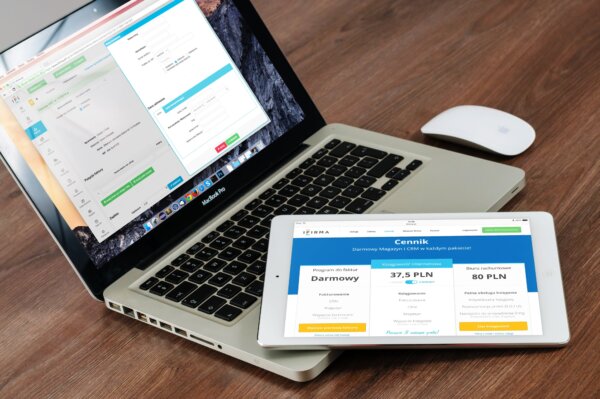
What is Customer Experience (CX)? (HINT: The Key to Your Next Record Sales Month)
Great customer experiences boost acquisition, revenue, conversion rates, and more. Here’s what it is and where to start today.
Many ecommerce stores put me through the same bad experience when I land on their homepage:
- Want our newsletter? (Get spammed with your sales and marketing ’email blasts’ every week? No thanks.)
- How about these cookies — those okay? (Sure?)
- Can we track your location? (Creepy! Why do you need that?)
- How about browser notifications? (Hard pass.)
- What size can our chatbot help you find? (Gah, I haven’t even made it through your pop-ups yet!)
It’s no wonder most visitors leave without making a purchase. Even if they make it past this barrage, landing pages often scream, “Look at how great WE are!” instead of, “How can we help YOU?”
The smartest ecommerce brands do something different.
They don’t prioritize cheap conversion tricks; they prioritize the customer’s experience — and profit because of it.
How?
For starters, enjoyable experiences are a phenomenal way to acquire and retain customers:
- PwC surveyed 15,000 consumers and found 65% of them said they were more strongly influenced by a positive experience than a great ad campaign.
- A separate study conducted by Oracle discovered 89% of consumers switched to a competing product or service because of a poor experience with their current provider.
(Also, turns out 86% of consumers will pay more for a better customer experience.)
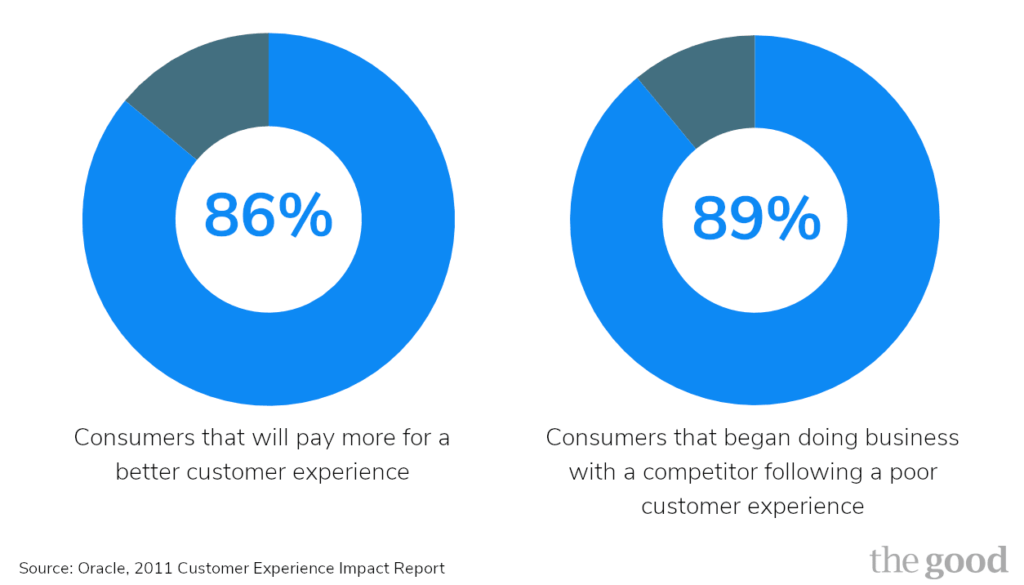
And then there’s the impact great customer experience has on repeat purchases and lifetime value:
- A report by Dimension Data found 92% of companies improving their customer experience saw an increase in customer loyalty
- 84% of those companies also saw an uplift in revenue
- 79% improved cost savings as well
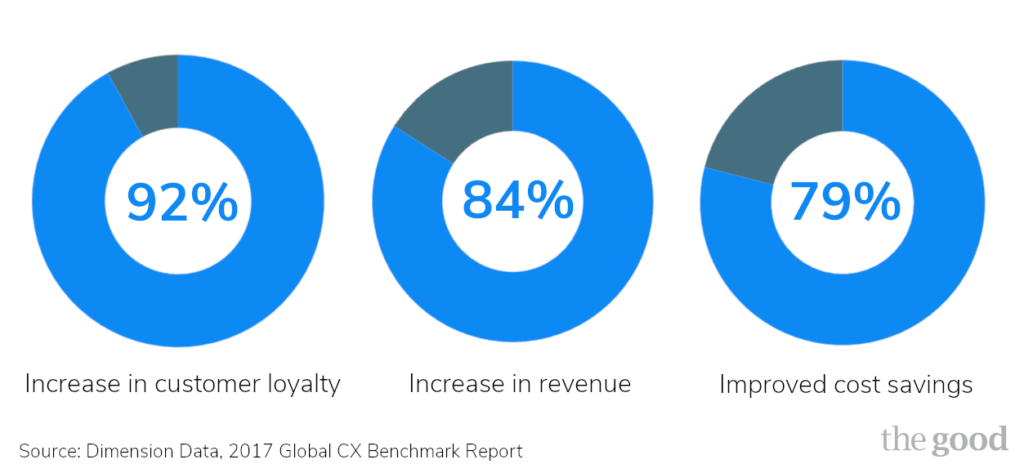
As Katelyn Bourgoin, CEO of Customer Camp put it…
If you wanna 2X your MRR, DOUBLE the time you invest in learning about your customer. Customer experience (CX) is the best growth hack.
— Katelyn Bourgoin ⚡️ (@KateBour) October 17, 2017
So, what exactly is CX and how do you start reaping its benefits?
This guide breaks it all down. From what goes into CX, to how to audit your current customer experience/customer journey, to how to make it a cornerstone of your brand.
Here’s what is in this guide:
- What is customer experience?
- What’s the difference between good, bad, and best-in-class CX?
- How do you audit the CX you’re providing?
- How do you improve your CX from there?
Note: In this guide, we’ll walk through a few examples of good and bad customer experiences. When we do this, it’s not to criticize unsuspecting ecommerce websites; it’s to provide constructive commentary. We respect any ecommerce brand who’s out there doing all the hard work running a business requires!
What is customer experience (CX) and what goes into it?
Let’s start at the top: what is this powerful revenue booster we’re calling “customer experience”?
When most brands think of CX, they think of customer support and product packaging. While those play a big role in how the customer experiences a brand, CX is much bigger than that.
Imagine a phenomenal shopping experience:
You pull up to a store and the facade looks clean and professional. Then you walk in and an associate pleasantly greets you. They offer to help in a non-sleazy way, the products are all clearly organized and labeled so you can easily find what you’re looking for, there’s no line at the checkout. On the way out, someone holds the door for you and says “Have a great day!” And you’re back in your car and off to the next task before you know it.
All of these touchpoints make up the customer experience in retail, and they all translate to ecommerce in one way or another. The “facade” is your homepage. The organized and labeled sections of the store is your navigation. The friendly sales associate is your website copy, product pages, help docs, and live chat. And so on.
Which means, customer experiences isn’t any one moment, channel, or team within a brand (though some progressive and well-funded companies do have a dedicated CX team). CX is the overall quality of interaction your customers have with your company. This includes:
- How easily the customer can accomplish their goals
- Whether your brand adds delight or friction to their journey toward that goal
- Every single brand impression along the way — word-of-mouth referrals, ads, chat, landing pages, your loyalty program, and more
It’s the sum of every interaction between a customer and your brand, from the first time they hear about you to the most recent touchpoint they’ve experienced.
We’ll look more closely at what pieces contribute to this sum below. But before we do that, let’s clear up a few misconceptions around what CX isn’t.
Customer experience (CX) vs. user experience (UX)
Some folks use customer experience (CX) and user experience (UX) interchangeably. They’re related but different:
- CX is concerned with across all channels and platforms
- UX is specifically concerned with the usability of your website, application, or product
If I’m trying to track down a merino sweater, and I can’t for-the-life-of-me find a relevant product category or filter in your navigation, that’s a UX problem. This may only slightly annoy me, or it may push me to head to another site. Either way, it contributes to a poor customer experience.
A good way to think about this is UX is an important part of CX, but it’s only a piece of the bigger picture.

Customer experience vs. customer service
Likewise, customer service is a part of CX but not the whole:
- Customer service is a specific team that’s often on the frontlines of the customer relationship.
- Customer experience (in a healthy and profitable company) is something every team focuses on — from the founder to the CTO to the newly-hired cashier — not just the customer service team.
We’ll mention UX and customer service in this guide because those are important parts of CX. But when we use the term, “customer experience,” keep in mind we’re talking about the end-to-end experience involving every aspect, team, touchpoint, and channel of the brand.
What are the components of CX?
What determines whether the quality of an experience is referral-worthy…or cringe-worthy?
To answer that question, we need to look more closely at what goes into CX — its components.
To get a good picture of these, imagine the first encounter between two characters who will fall in love in a movie. This is called a “meet-cute.” For example, when Jack talks Rose off the edge of the ship in Titanic.
The experience of that initial interaction is determined by:
- who those people are
- why they bump into each other
- what the interaction looks like
- and how they both interpret it
Likewise, for an ecommerce brand, customer experience is influenced by all these same factors — who, why, what, and how customers brush shoulders with your brand — with one important difference.
CX isn’t just the first time a customer meets or runs into you, it’s every time they interact with you.
Let’s look closer at those who, why, what, and how components from an ecommerce perspective.
The WHO
The two main characters here are the customer and your brand. Most brands know themselves (at least fairly well); where they fall short is knowing the customer. This includes:
- Gathering basic demographics (domestic or international?) and persona information
- Narrowing down who you serve…and who you don’t serve
- Identifying the types of customers coming to your site
- Building on demographics: what customers look like, how they act, how they speak
Take shaving and body care brand, Billie. ProfitWell reported how, from the start, Billie has focused on who they’re serving. This included honing in on women, and knowing they’re fed up with paying 10-15% more for razors while having 10x the surface area of men to shave.

This focus paid off. ProfitWell notes, “Women love them, so much so that Billie blew through their first year’s sales goal in just four months…All because they focused on the customer and in return—customers threw them thousands and thousands of glowing reviews.”
Where most brands get WHO wrong: Not understanding their customer well enough. Oftentimes, this is because the brand is collecting a detailed picture of their customer’s needs, pains, and desires. According to an In Moment survey, only 26% of brands are having direct conversations with customers about their experiences! It’s difficult to know your customer if you aren’t conversing with them or actively gathering feedback from them.
The WHY
Most of your website visitors come to you with a specific goal in mind. This is usually one of two things:
- Solving a problem they have
- Improving their life in some way
For example, I don’t shop for clothes to expand my wardrobe. If I’m looking for clothing, I’m trying to find something that will do one of the following:
- Make me feel confident (that sure looked good on them)
- Protect me against inclement weather (I’m tired of getting soaked)
- Improve my performance (on those root-filled trail runs)
- Or prepare me for a specific situation (overnight camping trip, or a wedding)
The majority of your customers already know what they are looking for and why they need it when they land on your site. Your primary objective is to help them learn about their options and facilitate a smooth transaction when they are ready to buy.
Where most brands get WHY wrong: Neglecting the customer journey for each type of customer. Many brands design their experience cold traffic. They fail to understand the nuance of context — men shop differently than women, self-purchasers shop differently than gift givers, cold traffic shops differently than referrals.
You need to understand why each type of customer is there and what desires, struggles, and motivations they have as they work toward their goals. This is what helps you determine what content to display where, how to structure your site and make numerous other decisions.
Stuart Balcombe, the founder of Discovery Sprints and host of DTC Voice of Customer podcast, told me this is where most brands go wrong with CX overall.
“Typically, brands start with themselves, with their product, with their business goals, and then they align everything around that. What the customer actually cares about is ‘How does this product help me make progress?’ and ‘Why do I need this product today, not six months ago and not six months from now?”
– Stuart Balcombe, Founder of Discovery Sprints
Brands who understand how their product fits into the customer’s life as a whole — instead of trying to squeeze the customer into their brand or founder goals — are the ones who get ahead.
The WHAT
The what piece is every interaction a customer (who) has with your brand during their journey (why). This includes every touchpoint on every channel:
- Pre-purchase: Word of mouth referrals, advertisements, social media, promos
- Purchase: pricing, shipping, product pages, upsells, credit card processing, testimonials
- Post-purchase: packaging, delivery, returns, customer service, marketing communications, forums, loyalty program, cancellations
Where most brands get WHAT wrong: Most brands focus an enormous amount of time and attention on everything leading up to the point of sale…and then they think their job is done. But dialing in other areas, like the post-purchase experience, can significantly accelerate their revenue growth.
The HOW
The final how piece is the way every one of the above interactions plays out. Do customers rage shut their computer because the page won’t load? Do they seamlessly find the perfect combination of items? How do they feel when they’re interacting with you?
Crafting a great how includes:
- On-site optimization informed by the who and why pieces above; once you’re clear on what paths customers are trying to take, you can help visitors move along those paths by presenting different offers based on past (or present) actions
- Welcoming, familiar language that speaks the customer’s vocabulary, not corporate jargon or confusing brand terms
- A balanced design that is attractive and engaging but doesn’t compromise trust, usability, or functionality.
- Technical considerations like image quality and page load speed
Enjoying this article?
Subscribe to our newsletter, Good Question, to get insights like this sent straight to your inbox every week.
Where most brands get HOW wrong: From 11+ years of reviewing ecommerce sites, one of the most common how mistakes we see is making experiences brand-centric instead of customer-centric.
This often looks like a navigation that’s all about the brand (“About Us”, “Press”) as opposed to one that helps the customer research and purchase. Or site language that hones in on product features…with no indication how those features add value to the customer.
For contrast, check out how Bare Performance Nutrition crafts their navigation around helping customers quickly find the right type of vitamin. It’s entirely oriented around the visitor’s fitness goals!

You get the idea: CX is multi-faceted and brands who want to do it well need to monitor a wide range of factors across every channel they maintain.
So, what does this look like in the wild?
What does bad vs. good CX look like?
While it’s human nature to want to sort overall experiences into goldilocks-style buckets — too hot, too cold, just right — the truth is most brands offer a mixed bag of experiences. Some parts of their CX are good, while other parts of the experience are bad.
Here’s how to figure out which one you’re looking at.
What is the difference between a bad and good experience?
Bad experiences introduce unhealthy friction
A bad experience is when a customer has a poor taste in their mouth (literally or figuratively) after interacting with your brand. This can include:
- Mismatched expectations
- Long wait times (e.g. “Please hold. You are number 87 in line.”) or long load times
- Buggy interfaces (“Why doesn’t this button work?”)
- Difficulty finding or exploring products
- Confusion or uncertainty (“Did my order go through okay?”)
- Poor product quality
Keep in mind, a poor experience isn’t always a major snafu that leaves a customer fuming. It’s anything that introduces unhealthy friction in the customer journey, big or small.
For example, yoga brand Gaiam allows you to filter by printed mats (a good first step)…but leaves you hanging with few ways to filter the remaining 50+ products. Keep in mind, an ecommerce site has two primary jobs:
- Help visitors learn about the options available to solve their problem or add value to their life
- Facilitate a smooth, painless transaction to help them purchase the product that’s right for them
Poor filtering adds friction to both jobs, so this counts as a frustrating experience.
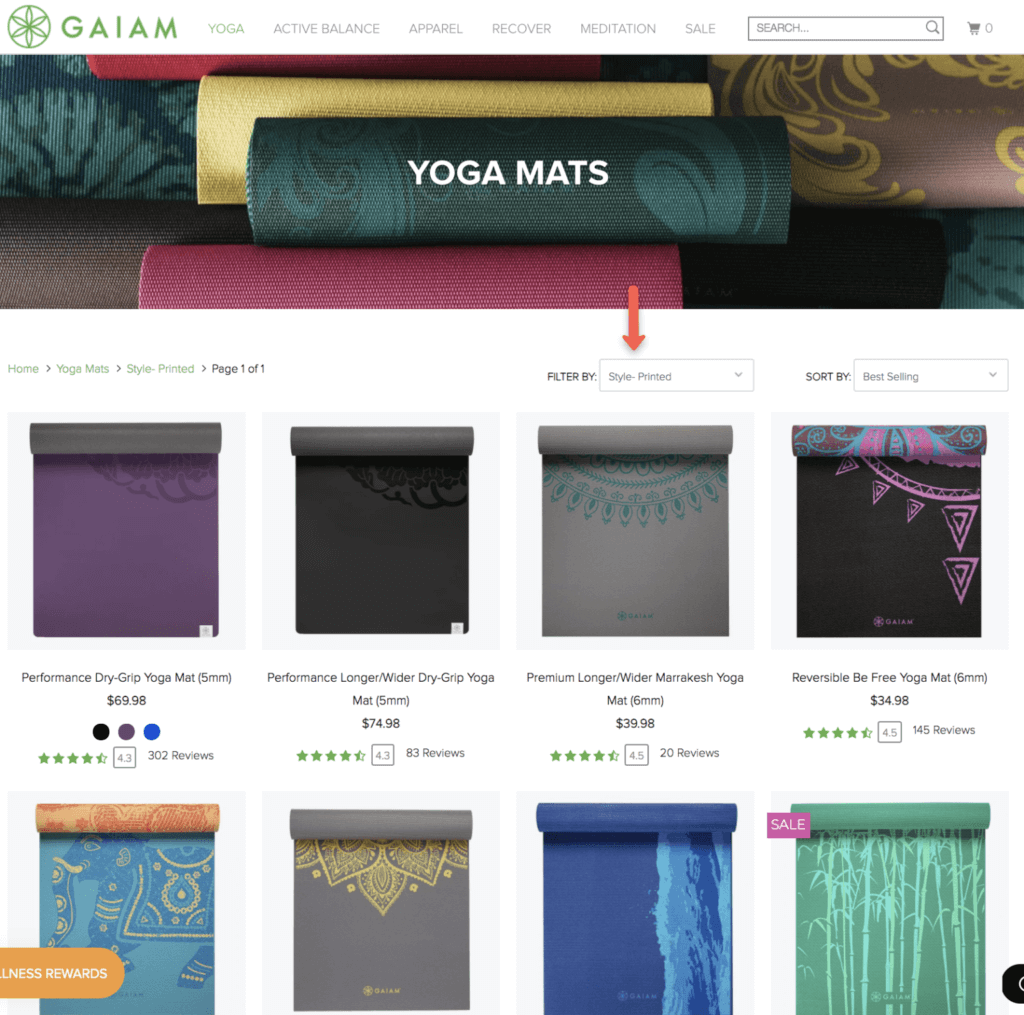
Good experiences serve the customer
A good experience, on the other hand, is when a customer feels positive about interacting with a brand.
This includes both big and small moments as well:
- A frustration turned into a resolution
- The right content at the right time
- A website that feels “easy” or “natural” to move around
- Support when and how you need it
- Content, pricing, and terms that match their expectations
For example, swimwear shopping is a frustrating experience for most women (including every one I know). Meaning, Andie Swimwear has an uphill battle from the start. Yet they tackle this frustration head-on with their Perfect Fit quiz. It’s based on data from thousands of women and the repeat questions Andie’s support team received.
From start to finish, the quiz is a great experience. But my favorite piece is the end. When you complete the quiz, you receive a personalized recommendation Andie automatically places in your cart — in the correct size.
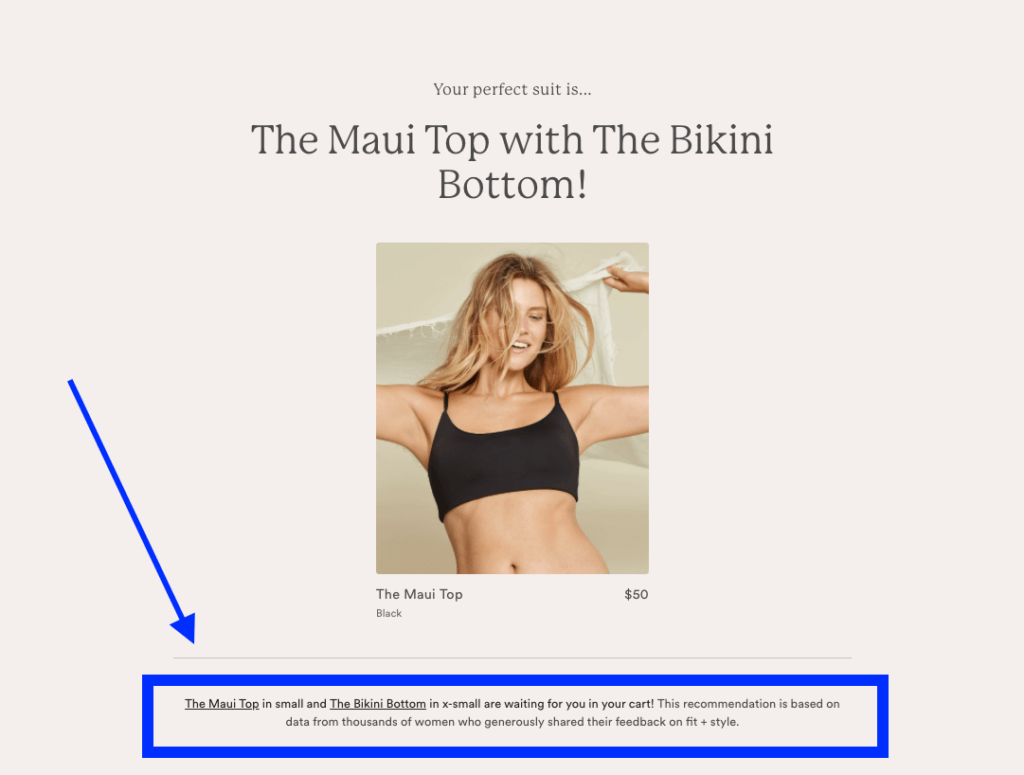
And I didn’t even have to give up my email for that! Talk about making swimsuit shopping easy and less frustrating.
Note: Want to do something similar? We talked with Ben Parr, founder of Octane AI, about personalization and crafting shoppable quizzes just like this one:
When good isn’t good enough: reaching best-in-class CX
Of course, sometimes good isn’t good enough – especially in a crowded marketplace.
XM examined feedback from 10,000 US consumers and found customers who have an “okay” experience are 72% likely to buy again vs. customers who have a “good” experience, which are 84% likely to purchase again. That’s a 12% jump between “okay” and “good.”
And if you bump up a “good” experience to a “very good” experience?
The percentage jumps another 10%, to 94% likely to purchase more!
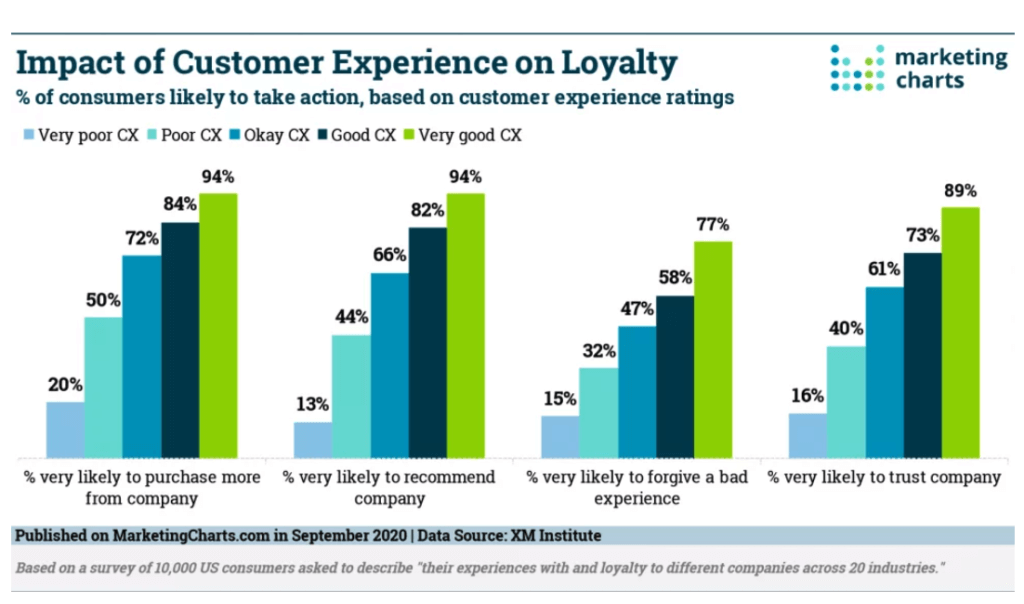
XM reported similar jumps in the customer’s likelihood to refer, forgive a poor experience, and trust the brand. There’s a lot to gain from going from an “okay” or “good” experience to best-in-class.
So, what does best-in-class look like?
In general, best-in-class brands seek out insights directly from their customers and use those learnings to inform design decisions related to page structure, headlines, product descriptions, and other site elements. And they separate themselves from the pack because of it.
Kristen LaFrance, Head of Resilient Retail at Shopify, recently broke down an example of an exceptional customer experience on Twitter.
So @meetblume just blew the roof off of upsell quality 👇
— Kristen LaFrance (@kdlafrance) December 3, 2020
Went to buy Meltdown for my bff. Instead found the perfect gift bundle 🎁
🔼 $30
Add to cart. Upsells for gift wrapping + personalized sticker (why not?!)
🔼 $5
Order value now $63 vs $28. One click checkout.
Boom 🤯 pic.twitter.com/5KywrOQ4Zt
Kristen started her journey by heading to the Blume site to buy a specific skincare product (Meltdown, a $28 standalone product) for her friend.
On her way there, she found the perfect skincare gift bundle for $58, which she added to her cart instead.
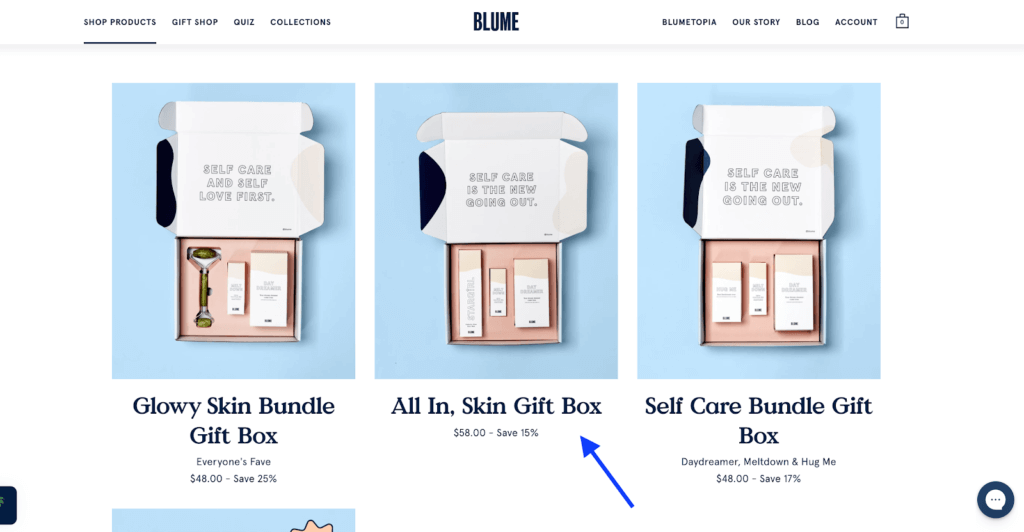
Then Blume pitched gift-wrapping and a personalized sticker for $4 and $1. Since this was a gift, she added that as well.
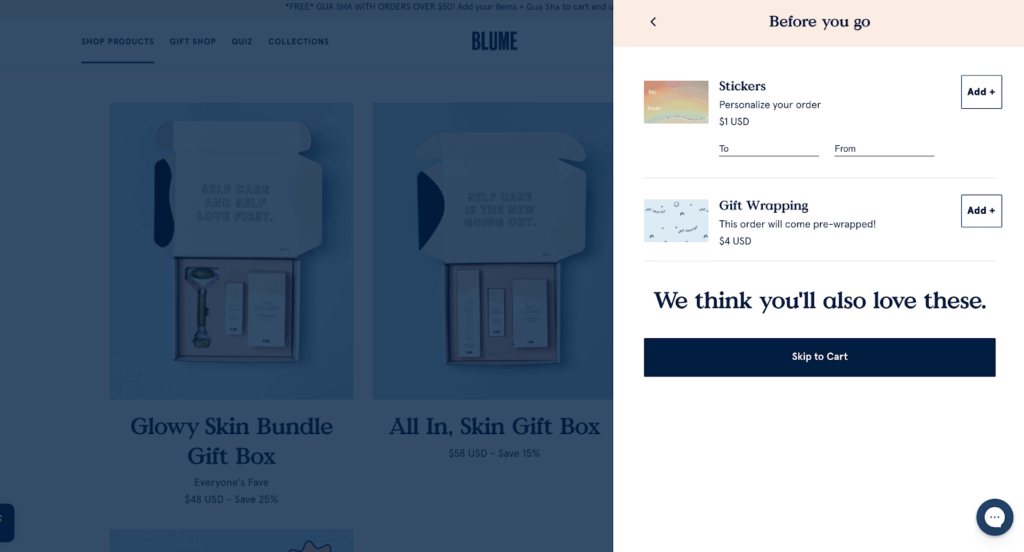
By the time she checked out, Kristen had spent $30 more than planned, loved doing so, and was just as excited as her friend for the package to arrive. As she pointed out, “That’s two excited customers for the (elevated) price of one. Wowza!”
A bonus for Blume? This rave review was posted to Kristen’s 8,000+ followers!
Are poor experiences really costing brands money?
“Whew,” some of you might be thinking, “best-in-class sounds great but sure looks like a lot of work — is it really worth it?”
The short answer is: yes.
As we mentioned up top, great experience leads to better acquisition, increased revenue, and more loyal customers. Poor experiences do just the opposite–they hinder acquisition, drain margin, and inspire churn.
Meaning, if you’re not addressing poor experiences, you’re likely seeing:
- Underperforming acquisition. Compared to five years ago, ProfitWell found the costs of acquiring new customers is 60% higher. Consumers have a larger pool of choices at a wider range of price points than ever before. With trends like this, you can’t afford to chase away first-time customers (and leak revenue) with poor first experiences.

- Poor reviews. According to Spiegel Research Center, nearly 95% of consumers read reviews before they make a purchase. And in today’s world, when someone has a bad experience with a product or service, they can let their whole world know. Worse, one study found that a consumer is 21% more likely to leave a review after a bad experience than a good one.
- High churn. Even if you have a herd of loyal fans, poor experiences work against you. According to PwC, one in three consumers will walk away from a brand they love after just one bad experience. In the U.S. 59% of consumers will walk away after several bad experiences. Meaning poor experiences don’t just cost you new customers — they cost you existing ones as well.
- Few referrals. Word of mouth is powerful, and if your CX isn’t dialed in, your customers might find your brand just “okay enough” instead of “brag worthy.” Meaning fewer word of mouth referrals from customers.
Lastly, there’s the opportunity cost. This is difficult to quantify, but it’s everything you’ve lost by not reaping the benefits of a great experience. Let’s say you attract 100 customers per month. If you have a poor customer experience, research shows that 20 of them will still buy from you again. But, if you have a very good customer experience, 75 of them will buy from you again. What could those 50+ additional purchases you earn every month mean for your business?
So, you have a lot to lose from poor experiences and a lot to gain from good ones. How do you audit your brand to find out where you can make improvements?
How to Audit Your Current Customer Experience
As we mentioned earlier, most brands provide a mixed bag of experiences; a few touchpoints are great, many are okay, and some are bad. This can make auditing your current experience a bit tricky — it’s more involved than saying either “wow, we’re doing great!” or “ugh, we’re really falling short.” And, there’s always room to improve; you’re never fully finished or optimized.
Tricky, but by no means impossible. To make auditing your brand’s customer experience manageable (the first time and every time after that), you’ll want to do two key things:
- Map out the current, holistic experience using a customer journey map
- Keep a sharp eye out for common, easy-to-miss hot spots
- Get third-party help seeing what you’ll otherwise miss
Let’s look at each one.
1. Map out your current customer journey
Remember, CX includes every interaction your customer has across every touchpoint and channel.
To build a clear picture of the overall experience, you’ll want to start by mapping the customer journey.
From an ecommerce perspective, the “customer journey” maps how customers interact with your brand — from the customer’s perspective. (Compared to sales and marketing funnels, which are usually from the brand’s perspective.)
It integrates data from all your tools and research into a unified view. Broadly speaking, it gives you the ability to “walk in your customer’s shoes” and identify glaring pain points you may have missed otherwise. (Reminder: interview your customers! If you talk with 10-20 customers about how they found you and what purchasing from you was like, you’ll be able to map out several journeys.)
Here’s an example of what a journey map can look like, but keep it mind yours doesn’t have to be this polished:
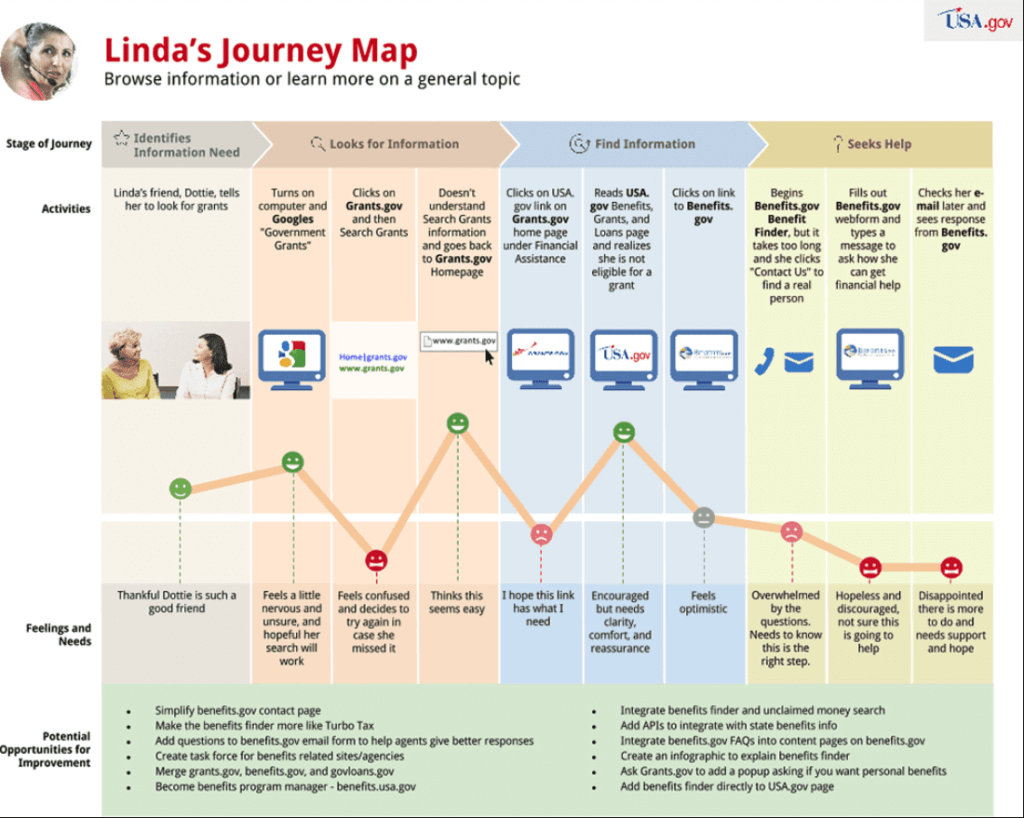
If you’re not familiar with these, they may strike you as another trendy marketing tool. And yes, journey maps are in fashion — but for good reason!
How a journey map significantly improves CX
Pointillist surveyed over 1,050 CX, analytics, and marketing professionals and discovered 95% of organizations have adopted a journey-based approach to CX, and 8 in 10 respondents say a journey-based strategy is critical to the overall success of the business.

In fact, the journey is so important, over 50% of companies also have a dedicated role or team in place to manage it.
Why all the hype?
Well, from a CX perspective, a good journey map helps you do several important things:
- Clarify the entire customer journey from the very beginning — the real beginning, not just when they hit your site — to the point where they become a loyal advocate or jump ship
- Segment different stages of that journey (e.g. consideration and purchase)
- Outline customers goals and preferences for the entire journey, as well as each segment
- Identify what customers and thinking and feeling at every stage
- Pinpoint pain points, bottlenecks, common frustrations, and friction
- Personalize experiences across channels
- Hone in on brand opportunities to improve customer experience
The bottom line is, the more you know about your customers, the quicker and easier you can improve their experience with every part of your brand.
Never created a journey map before? Here are some good resources for getting started:
- How to create a customer journey map by Hotjar
- Customer Journey Maps — Walking a Mile in Your Customer’s Shoes by the Interaction Design Foundation
- How to Make an Effective Customer Journey Map by CoSchedule
2. Keep a sharp eye out for common customer experience mistakes
In 11+ years of business, we’ve seen plenty of customer experience mistakes (and, encouragingly, plenty of brands eager to correct them!). Use the most common mistakes below to audit the experiences you provide.
Common strategic mistakes
- Auditing off competitors. It’s tempting to audit your competitor’s CX and simply copy them. Don’t! Instead, focus on what experiences you want your customers to have based on your brand and your business goals. You win the competition by being the best, not by copying everyone else.
- Focusing on your message instead of what the customer wants to hear. It’s important that your site reflects the identity and message of your brand, but it should primarily serve the goals of the consumer. Too many brands default to ‘feature dumping’ and talking about how great their products and their company are, when what a site visitor really cares about is how those products can improve or enrich their own life.”
- Using intuition rather than data. If you invest some time and resources into listening to what customers want (through interviews, data, testing and other means), they’ll tell you what improvements you need to make. Unfortunately, too many brands rely on guesswork instead.
Common tactical mistakes
- Crowding your website pages with jargon and marketing. Use pages to highlight products your best customers are buying, images that inspire, and content that is actually consumed by visitors. I’ll say it one more time for the people in the back…survey and interview your customers. Transcribe those interviews and use their language in your headlines, ad copy, and product descriptions. This is so easy, so effective, and so often overlooked.
- Filling the page with unnecessary information. Too many brands think they need long, detailed homepages and product pages. Those can be great — when done properly — but don’t shoehorn your blog posts or aspirational quotes into the page unless they address customer concerns or answer customer questions.
- Installing “features” that act as roadblocks. Email pop-ups, rotating carousels, and brand-focused navigation may all seem like perks for your brand, but they’re roadblocks for your customers. Avoid these.
3. Get third-party insights for extra clarity
Auditing your site with a journey and a mistake checklist is going to get you a long way. But, as we often point out, it’s hard to read the label from inside the jar. Meaning, there’s only so much perspective you can gain from inside the business.
That’s why it’s often helpful to work with a third party. They can help you see pieces you missed or help your team get further, faster. If you’re an early-stage ecommerce brand, this could mean simply relying on useful third-party tools.
Useful third-party tools
- Google analytics
- Heatmaps
- Survey tools
Note: We detail options for these tools, how to set some of them up, and the best ways to use them in How To Improve Your Conversion Rate When You Have More Time Than Money.
If you’re further along than early-stage, you’d likely benefit from tools and human support. This could mean a mastermind or an agency or consultancy.
Masterminds
If you ask around, you may find there’s a Slack or private group of ecommerce leaders you can join. If not, you could always create your own mastermind group: pull together a diverse group of ecommerce founders or leaders you respect and take turns auditing each other’s experience. Or, have them review an audit you do yourself.
Third-party consultants and agencies
If you’d benefit from an even more hands-on approach, an agency like The Good could be a helpful option. For example, our Conversion Growth Assessment™ is a great companion to your CX audit. It’s not an end-to-end solution, but it’s a great starting point to learn why your site isn’t converting and how to fix it.
How to put together an improvement plan post-audit
You’ve identified areas of improvement. Now, you need to make sure those “where to improve” notes don’t die in a Google Doc somewhere. You need some kind of improvement plan.
Putting one together usually includes:
- Prioritizing your resources (start with high impact, low investment)
- Measuring the impact
- Creating a “CX Culture” (institutionalizing a customer-first approach)
Here’s each of those in detail.
Where do you prioritize your efforts?
While every piece of CX matters — because every piece can be a memorable good or bad experience — you’ll need to prioritize your initial improvements. After all, it’s unreasonable for even big brands to tackle everything at one time.
Here are three ways to start prioritizing:
1. Peak-end components
It’s tempting to think each part of a customer’s experience is equally weighted — as if that Facebook ad is one point, the homepage is another point, and so on.
But psychology indicates this isn’t how we recall interactions. Rather, we pay extra attention to the intense highs/lows and final moments of any experience. This is called the “peak-end” rule.
If you have a detailed customer journey map, that will help you pinpoint those for your brand (your customers will tell you what’s most memorable). Here’s some additional guidance.
Peaks include moments customers realize your product is helpful, valuable, or delightful. They also include particularly negative interactions, such as moments of confusion or frustration. For example:
- Positive peak: discovering the perfect fit
- Negative peak: website crashing when you’re ready to purchase
Ends, on the other hand, include the final step of a task or journey segment. For example:
- Hitting the purchase button
- Reaching a certain rewards level
If you have the opportunity to improve a positive peak, eliminate a negative peak, or strengthen an end experience, dig into those.
2. Components consumers prioritize
Another good way to prioritize improvements is to prioritize what your customers prioritize.
According to research by PwC, 80% of American consumers point to speed, convenience, knowledgeable help, and friendly service as the most important elements of customer experience.

If you’re falling particularly flat in any of those categories, consider doubling down there for starters.
However, one caveat: keep in mind this data is from a wide range of consumers. In all likelihood, your customers have similar priorities, but if you can find out what your specific customers say is important (via surveys or interviews), that’s even better!
3. Poor-performing components
Metrics (Google Analytics, heatmaps, etc) may give you another option for prioritizing.
Bad stats are great options for good tests. For example, pages with high bounce rates, low conversion rates, or unusual data are prime candidates for user testing. Choose a handful of poorly performing pages, send testers to those pages, and assign goals you expect your customers to perform on those pages.
Some generic goals for user tests that you can make more specific to your brand and products include:
- Find a product and add it to the cart
- Use search to locate a particular product
- Use the product filters to locate a particular product
- Add multiple products to the cart and attempt to check out
- Find support information for a particular product
- Attempt to make a product return
- Find answers to common questions about a specific product
Keep in mind it’s possible you have a poor experience that checks all three of these boxes: it’s a peak-end component, it’s a priority to customers, and it’s poor-performing. If that’s the case, by all means, start there!
How do you measure success?
As you start making the improvements, you’ll want to know, “Is this working?”
There are a few ways to measure that, and they’re listed below. Generally speaking, if you’re providing a great experience, you’ll see a handful of metrics go up and another handful of metrics go down.
Note: Because we cover these metrics in detail elsewhere, we’re going to stick with an overview here.
Quantitative metrics
Quantitative metrics are ones you can represent numerically. They’re what most folks think of as “hard” metrics and they primarily address “what is happening?”.
If you’re providing a good experience, you’ll see these quantitative metrics go up:
Whereas these will go down:
For example, remember that quiz from Andie we looked at earlier? That one good experience has been an incredible conversion tool for them. On Future Commerce, Andie (the CEO and founder) explains how it’s impacted return on ad spending in particular. Her teams discovered a woman is more likely to purchase if she lands on the Fit Quiz vs. any random product page.

So, they applied this insight to ad strategy. Andie explains, “We spend a lot of money on Facebook and the majority of our Facebook ads dropped a woman right into the Fit Quiz because we just know she’s more likely to purchase.”
Qualitative metrics
Qualitative metrics focus less on numbers and more on the consumer. They help explain behaviors behind quantitative metrics; they address “why is that happening?”
If you’re providing a good experience, you’ll see these qualitative metrics go up:
- Quality of reviews
- Quality of other user-generated content
- Referrals
- More positive customer sentiment
- Engaged, positive community discussion
Whereas these go down:
- Complaints
- “Basic” support questions (even if your overall support load doesn’t decrease, you’ll usually spend less time answering 101-type questions because you address those on the site)
Take direct-to-consumer makeup darling, Glossier. From advertising to website copy to product packaging, Glossier provides a customer experience that resonates with their fans (informed by the feedback they gather from a wide variety of channels). This is intentional.
Founder Emily Weiss told re/code, “The way we look at it is that we’re building this people-powered ecosystem…we have a direct relationship with every single person who buys something from us, unlike all of the incumbent companies that have built through retail channels.”

This approach has been incredibly effective, too. Weiss attributes 90% of revenue growth to fans and their word-of-mouth marketing!
One last thing: as you’re tracking and measuring customer experience, keep two caveats in mind:
- The goal isn’t a “perfect” experience (if such a thing even exists!). It’ s an experience that’s continually improving, reflected by key metrics that are continually improving. As we like to say, “The goal is to get 1% better every day.”
- Experience includes, but goes well beyond, numbers and graphs. Make sure you monitor hard and soft indicators the experience is improving.
How do you make customer experience a regular part of your operations/culture?
Doing an audit and making improvements once is great. Putting the customer at the center of your business every week, month, and quarter is even better. That’s how you reap not just the immediate rewards of providing great experiences, but the compound ones too.
Take AmEx. Financial Times reported how they made a big shift from viewing the customer experience as a cost to viewing it as an opportunity. They invested in understanding their customers, improving processes, and making other leaps. The result? 400% increase in customer retention. As AmEx kept customer relationships their main strategy, they were able to move into other aspects of the customer’s life as well, like travel and entertainment.
So, how do you make a similar transition to ensure every time you set up a landing page, campaign, or new product, your teams are thinking about the customer?
No two journeys are the same, but they usually involve several shared elements:
- Top-level buy-in: For individual teams to have the resources, tools, and processes they need to prioritize the customer, the founder and senior leaders need to be on board with putting the customer first.
- Incentivize good experiences: From who you hire, to team KPIs and bonuses, individuals need to be incentivized to put the customer first. Kate Showalter, Senior Director of Customer Service for Crate and Barrel, told Future Commerce how her team isn’t incentivized by sales. This was a huge help for the service team. It meant engaging with customers “didn’t feel so much like selling to them, it just felt like helping.”
- Empower good experiences: Incentives are a great start, but they only go so far if teams aren’t equipped to meet those incentives. This, too, is something Crate and Barrel tackles. Showalter explained, “We also have to make sure our associates feel confident and comfortable…So we’ve heightened all of our product training.” Point employees toward great experiences — then empower them to provide those. Train them on what “right” looks like, show examples of good and bad experiences, give them authority to do “anything up to [x] to make the situation right”, and encourage them to share good experiences and lessons learned.
- Give everyone access to the customer: This could look like Glossier’s mandatory 2-hour retail shifts for new hires (literally putting employees in front of customers) or ensuring every employee does at least one round at the support desk. It could also look like making sure all teams are tiehr equipped to do customer interviews, or have access to customer interview data. Stuart Balcombe told me, “The more people you can have with direct contact with customer voice, the better.” That way, they can keep a pulse on the audience and make decisions in the customer’s best interests.
Overall, the goal of doing these things is to become an increasingly customer-centric organization — the kind that has the customer at the heart of everything they do, not just in marketing subject lines.
Improving your CX is more than worth the effort
Crafting a customer journey map, auditing your overall CX, and making improvements will demand a decent amount of time and effort— from you, as well as from your teams.
However, keep in mind that time and effort is more than worth it:
- 65% of consumers find a positive experience more influential than marketing
- 89% of consumer began doing business with a competitor after a poor experience
- 86% of consumers will pay more for a better customer experience
- Only 20% of consumers will buy again after a poor experience, whereas 94% of consumers will buy again after a very good experience
- 84% of companies improving their experience saw an uplift in revenue
CX may feel like a “soft” approach to improving revenue, but the data shows it impacts critical hard metrics like return on ad spending, conversion rate, average order value, and customer lifetime value.
So, set aside some time to map out your customer journey, audit your customer’s experience, and identify where you can start making improvements.
The ROI is more than worth it.

About the Author
Laura Bosco
Laura Bosco is our Lead Content Marketer at The Good and a phenomenal freelance writer. She helps us translate our thoughts, opinions, and client experiences into written products that are both entertaining and educational. You can learn more about her background and her services at www.laurabosco.com.